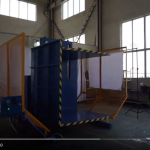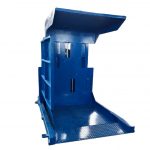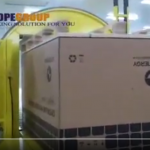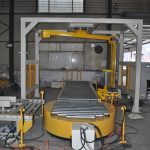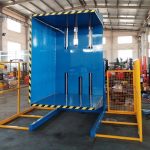Presenting a Data-Driven Case for Implementing Pallet Inverters in Your Warehouse
- Presenting a Data-Driven Case for Implementing Pallet Inverters in Your Warehouse
- 1. What is a Pallet Inverter, and How Does It Work?
- 2. Key Benefits of Implementing Pallet Inverters
- 3. Data-Driven Evidence: ROI of Pallet Inverters
- 4. Enhancing Warehouse Safety with Pallet Inverters
- 5. Adapting to Warehouse Scalability
- 6. Real-World Case Studies of Pallet Inverter Implementation
- Conclusion: The Future of Warehouse Efficiency Lies in Automation

Pallet inverters have become a crucial part of modern warehouse operations, providing businesses with an efficient solution for pallet handling and load stability. However, many warehouse managers hesitate to invest in these machines, unsure if the costs outweigh the benefits. In this article, we will present a data-driven case for implementing pallet inverters in your warehouse. Through the lens of operational efficiency, cost reduction, and safety improvements, you will see how pallet inverters can optimize your processes and deliver long-term value.
1. What is a Pallet Inverter, and How Does It Work?
A pallet inverter is a mechanical device that allows for the rotation of loaded pallets, enabling the replacement of damaged or suboptimal pallets without manual labor. By clamping the load and rotating it up to 180 degrees, the pallet can be easily swapped or removed. This solution is ideal for warehouses that frequently deal with damaged goods, unstable loads, or require pallet changing as part of their processes.
While traditional methods involve manually restacking goods or using forklifts in potentially unsafe ways, pallet inverters automate the process, improving both speed and safety. Pallet inverters can be fully automated or semi-automated, depending on the needs and budget of the warehouse.
2. Key Benefits of Implementing Pallet Inverters
a) Increased Efficiency
Manual pallet handling processes are often time-consuming and labor-intensive. On average, a worker may take up to 20 minutes to manually transfer goods from one pallet to another. In a warehouse dealing with high volumes, this can translate to significant labor costs and downtime.
With a pallet inverter, this process can be reduced to under five minutes. This translates to a potential 300% improvement in efficiency for pallet handling tasks. By minimizing the manual effort involved, workers can focus on higher-value tasks, and overall productivity increases.
b) Cost Savings on Labor
Pallet inverters reduce the need for additional workers to manually handle pallet exchanges. For example, in a warehouse where 10 employees are tasked with pallet handling, the introduction of an inverter can reduce this number to three or fewer workers, cutting labor costs significantly.
Furthermore, pallet inverters often reduce the risk of injury, particularly related to musculoskeletal disorders caused by repetitive strain. According to the Bureau of Labor Statistics (BLS), back injuries alone account for nearly 20% of all workplace injuries. By automating the heaviest and most dangerous tasks, pallet inverters can reduce these injuries and save on compensation and healthcare costs.
c) Improved Load Stability
Unstable loads are a common issue in warehouses, especially when transferring goods between different pallet types. With a manual process, there is always a risk of tipping or damaging products, which can lead to inventory losses and increased costs.
Pallet inverters maintain load integrity throughout the handling process. By securely clamping goods during rotation, the machine ensures that the load stays intact, minimizing the risk of damages or accidents. This is particularly important for industries like pharmaceuticals, food, and fragile goods, where product damage can lead to significant losses.
d) Versatility Across Different Pallet Sizes and Types
One of the key advantages of pallet inverters is their ability to handle different types of pallets. Many warehouses deal with various sizes of pallets, including EURO, CHEP, and GMA pallets. A pallet inverter can be configured to accommodate all these types, eliminating the need for different handling equipment.
Additionally, pallet inverters are compatible with a wide range of materials, including wood, plastic, and metal pallets. This versatility makes them an ideal investment for warehouses that handle diverse product lines.
3. Data-Driven Evidence: ROI of Pallet Inverters
The return on investment (ROI) for pallet inverters can be calculated based on reduced labor costs, decreased downtime, and fewer product damages. According to research by Material Handling Industry (MHI), companies that implemented pallet inverters saw an average of 30-40% reduction in labor costs related to pallet handling.
For instance, a warehouse handling 1,000 pallet changes per week at $20 per hour labor cost would spend approximately $20,000 per month on manual pallet handling. By reducing this labor by 50% with a pallet inverter, the monthly cost drops to $10,000, providing a $120,000 annual saving.
When combined with reduced product damages and injury costs, the ROI can often be realized within one to two years, making pallet inverters a cost-effective investment.

Get Your Best Solution !
4. Enhancing Warehouse Safety with Pallet Inverters
Safety is a top priority for warehouse managers, and pallet inverters contribute significantly to reducing workplace accidents. Manual pallet handling can expose workers to slips, falls, and strain injuries. With the automation provided by pallet inverters, these risks are minimized.
A study by OSHA (Occupational Safety and Health Administration) highlights that over 50% of pallet-related injuries involve the manual handling of goods. The implementation of a pallet inverter can drastically reduce these incidents, creating a safer working environment and leading to lower workers’ compensation costs.
Additionally, pallet inverters contribute to a more ergonomic workplace, as they eliminate the need for workers to lift and twist heavy loads repeatedly. This reduction in repetitive strain helps in preventing long-term injuries and maintaining a healthier workforce.
5. Adapting to Warehouse Scalability
As businesses grow, their operational needs evolve. A pallet inverter is a scalable solution that can easily integrate with other automation technologies, such as automated guided vehicles (AGVs) or warehouse management systems (WMS). Whether you’re managing a small warehouse or a large distribution center, pallet inverters offer flexibility to scale up operations without significant disruptions.
Furthermore, pallet inverters can handle various pallet sizes, including custom-sized pallets used in specific industries. This adaptability makes pallet inverters an essential tool for businesses looking to future-proof their operations.
6. Real-World Case Studies of Pallet Inverter Implementation
Many companies have already reaped the benefits of pallet inverters. For instance, Company X, a leading food distribution center, faced challenges with pallet exchanges due to stringent hygiene standards. They needed a solution that could handle both inbound and outbound pallets without cross-contamination.
After implementing pallet inverters, Company X saw a 50% reduction in handling time and a 70% improvement in worker safety. Similarly, Company Y, a pharmaceutical company, reduced product damage during pallet exchanges by 35% after switching to pallet inverters.
These real-world case studies highlight the tangible benefits that come with automating pallet exchanges, helping companies streamline their operations, cut costs, and improve overall safety.
Conclusion: The Future of Warehouse Efficiency Lies in Automation
Pallet inverters offer a compelling solution for warehouses looking to improve efficiency, reduce costs, and enhance safety. By automating pallet exchanges, businesses can eliminate manual labor, minimize product damage, and create a safer working environment. The data speaks for itself: investing in pallet inverters provides long-term ROI, making it a smart choice for any forward-thinking warehouse operation.
With the ability to handle diverse pallet sizes and types, pallet inverters are also a future-proof investment that can scale with your business. As more companies look toward automation to streamline their operations, pallet inverters will continue to play a pivotal role in shaping the future of warehouse management.
If you’re ready to improve your warehouse’s efficiency and safety, now is the time to consider implementing pallet inverters.

Get Your Best Solution !


